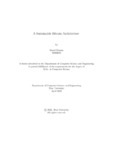A sustainable Bitcoin architecture
Abstract
Cryptocurrencies are the new form of trade that has revolutionized how we look
into our financial institutions. Bitcoin dominates the industry with the highest
market share among the hundreds of other cryptocurrencies. However, high energy
consumption leading to increasing carbon emission, prioritizing high-value transactions,
and long waiting times are some of the flaws preventing it from reaching
its full potential. Due to the block rewards getting halved every four years, miners
and researchers are fearful that this would be the breaking point of Bitcoin’s
success. One of the ways to tackle and hopefully reduce this problem while bringing
wider adaptability is by ensuring faster transactions. Currently, Bitcoin has an
average block size of 1MB, which many researchers and enthusiasts believe is insufficient.
To tackle these limitations, we have proposed two different ideas. Our first
concept proposes an industry 4.0 compliant next-generation Bitcoin architecture by
introducing a dynamic and sustainable block concept. Using our improved knapsack
algorithm, a priority-based 0/1 knapsack and advanced priority-based 0/1 knapsack,
we can ensure a balanced transaction selection, quicker verification, higher transaction
throughput, reduced carbon emission, and increased earnings for the miners.
Moreover, with the addition of only one of our proposed sustainable blocks, we can
cut down verification times by 50% and increase throughput by 2.56 times. We can
also reduce carbon emissions per transaction by 62.318%, which would help reduce
Bitcoins’ large carbon footprint, enabling us to approach greener digital transactions.
In the second concept, we further try to improve the block sizes using the help
of machine learning and artificial intelligence. Our proposed model analyzes the
network’s activity, such as incoming transaction frequency and other aspects, to
adjust block sizes. The model can predict block sizes with 61.12% accuracy, and we
can see a positive change in the amount of fees earned by miners (9.3%), transaction
count and transaction per second (66.75%). With the help of our model, Bitcoin
would be able to dynamically change the block size based on the transaction activity,
resulting in shorter wait times, thus increasing wider adaptability and sustainability.

